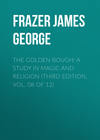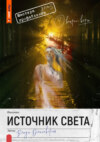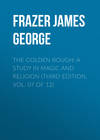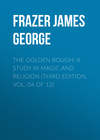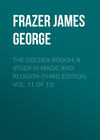Читать книгу: «The Golden Bough: A Study in Magic and Religion (Third Edition, Vol. 08 of 12)», страница 13
§ 5. Killing the Sacred Bear
Ambiguous attitude of the Aino towards the bear
Doubt also hangs at first sight over the meaning of the bear-sacrifice offered by the Aino or Ainu, a primitive people who are found in the Japanese island of Yezo or Yesso, as well as in Saghalien and the southern of the Kurile Islands. It is not quite easy to define the attitude of the Aino towards the bear. On the one hand they give it the name of kamui or “god”; but as they apply the same word to strangers,546 it may mean no more than a being supposed to be endowed with superhuman, or at all events extraordinary, powers.547 Again, it is said that “the bear is their chief divinity”;548 “in the religion of the Aino the bear plays a chief part”;549 “amongst the animals it is especially the bear which receives an idolatrous veneration”;550 “they worship it after their fashion”; “there is no doubt that this wild beast inspires more of the feeling which prompts worship than the inanimate forces of nature, and the Aino may be distinguished as bear-worshippers.”551 Yet, on the other hand, they kill the bear whenever they can;552 “in bygone years the Ainu considered bear-hunting the most [pg 181] manly and useful way in which a person could possibly spend his time”;553 “the men spend the autumn, winter, and spring in hunting deer and bears. Part of their tribute or taxes is paid in skins, and they subsist on the dried meat”;554 bear's flesh is indeed one of their staple foods; they eat it both fresh and salted;555 and the skins of bears furnish them with clothing.556 In fact, the worship of which writers on this subject speak appears to be paid chiefly to the dead animal. Thus, although they kill a bear whenever they can, “in the process of dissecting the carcass they endeavour to conciliate the deity, whose representative they have slain, by making elaborate obeisances and deprecatory salutations”;557 “when a bear has been killed the Ainu sit down and admire it, make their salaams to it, worship it, and offer presents of inao”;558 “when a bear is trapped or wounded by an arrow, the hunters go through an apologetic or propitiatory ceremony.”559 The skulls of slain bears receive a place of honour in their huts, or are set up on sacred posts outside the huts, and are treated with much respect: libations of millet beer, and of sake, an intoxicating liquor, are offered to them; and they are addressed as “divine preservers” (akoshiratki kamui), or “precious divinities.”560 The skulls of foxes are also fastened to the sacred posts outside the huts; they are regarded as charms against evil spirits, and are consulted as oracles.561 Yet it is expressly said, “The live fox is revered just as little as the bear; rather they avoid it as much as possible, considering it a wily animal.”562 The bear can hardly, therefore, be [pg 182] described as a sacred animal of the Aino, nor yet as a totem; for they do not call themselves bears, and they kill and eat the animal freely. However, they have a legend of a woman who had a son by a bear; and many of them who dwell in the mountains pride themselves on being descended from a bear. Such people are called “Descendants of the bear” (Kimun Kamui sanikiri), and in the pride of their heart they will say, “As for me, I am a child of the god of the mountains; I am descended from the divine one who rules in the mountains,” meaning by “the god of the mountains” no other than the bear.563 It is therefore possible that, as our principal authority, the Rev. J. Batchelor, believes, the bear may have been the totem of an Aino clan; but even if that were so it would not explain the respect shewn for the animal by the whole Aino people.
Aino custom of catching a bear cub, rearing it for several years, and killing it at a solemn festival
But it is the bear-festival of the Aino which concerns us here. Towards the end of winter a bear cub is caught and brought into the village. If it is very small, it is suckled by an Aino woman, but should there be no woman able to suckle it, the little animal is fed from the hand or the mouth. If it cries loudly and long for its mother, as it is apt to do, its owner will take it to his bosom and let it sleep with him for a few nights, thus dispelling its fears and sense of loneliness. During the day it plays about in the hut with the children and is treated with great affection. But when the cub grows big enough to pain people by hugging or scratching them, he is shut up in a strong wooden cage, where he stays generally for two or three years, fed on fish and millet porridge, till it is time for him to be killed and eaten.564 But “it is a peculiarly striking fact that the young bear is not kept merely to furnish a good meal; rather he is regarded and [pg 183] honoured as a fetish, or even as a sort of higher being.”565 In Yezo the festival is generally celebrated in September or October. Before it takes place the Aino apologise to their gods, alleging that they have treated the bear kindly as long as they could, now they can feed him no longer, and are obliged to kill him. A man who gives a bear-feast invites his relations and friends; in a small village nearly the whole community takes part in the feast; indeed, guests from distant villages are invited and generally come, allured by the prospect of getting drunk for nothing. The form of invitation runs somewhat as follows: “I, so and so, am about to sacrifice the dear little divine thing who resides among the mountains. My friends and masters, come ye to the feast; we will then unite in the great pleasure of sending the god away. Come.”566 When all the people are assembled in front of the cage, an orator chosen for the purpose addresses the bear and tells it that they are about to send it forth to its ancestors. He craves pardon for what they are about to do to it, hopes it will not be angry, and comforts it by assuring the animal that many of the sacred whittled sticks (inao) and plenty of cakes and wine will be sent with it on the long journey. One speech of this sort which Mr. Batchelor heard ran as follows: “O thou divine one, thou wast sent into the world for us to hunt. O thou precious little divinity, we worship thee; pray hear our prayer. We have nourished thee and brought thee up with a deal of pains and trouble, all because we love thee so. Now, as thou hast grown big, we are about to send thee to thy father and mother. When thou comest to them please speak well of us, and tell them how kind we have been; please come to us again and we will sacrifice thee.” Having been secured with ropes, the bear is then let out of the cage and assailed with a shower of blunt arrows in order to rouse it to fury. When it has spent itself in vain struggles, it is tied up to a stake, gagged and strangled, its neck being placed between two poles, which are then violently compressed, all the people eagerly helping to squeeze the [pg 184] animal to death. An arrow is also discharged into the beast's heart by a good marksman, but so as not to shed blood, for they think that it would be very unlucky if any of the blood were to drip on the ground. However, the men sometimes drink the warm blood of the bear "that the courage and other virtues it possesses may pass into them"; and sometimes they besmear themselves and their clothes with the blood in order to ensure success in hunting. When the animal has been strangled to death, it is skinned and its head is cut off and set in the east window of the house, where a piece of its own flesh is placed under its snout, together with a cup of its own meat boiled, some millet dumplings, and dried fish. Prayers are then addressed to the dead animal; amongst other things it is sometimes invited, after going away to its father and mother, to return into the world in order that it may again be reared for sacrifice. When the bear is supposed to have finished eating its own flesh, the man who presides at the feast takes the cup containing the boiled meat, salutes it, and divides the contents between all the company present: every person, young and old alike, must taste a little. The cup is called “the cup of offering” because it has just been offered to the dead bear. When the rest of the flesh has been cooked, it is shared out in like manner among all the people, everybody partaking of at least a morsel; not to partake of the feast would be equivalent to excommunication, it would be to place the recreant outside the pale of Aino fellowship. Formerly every particle of the bear, except the bones, had to be eaten up at the banquet, but this rule is now relaxed. The head, on being detached from the skin, is set up on a long pole beside the sacred wands (inao) outside of the house, where it remains till nothing but the bare white skull is left. Skulls so set up are worshipped not only at the time of the festival, but very often as long as they last. The Aino assured Mr. Batchelor that they really do believe the spirits of the worshipful animals to reside in the skulls; that is why they address them as “divine preservers” and “precious divinities.”567[pg 185]
Dr. Scheube's description of the Aino custom of killing of a bear ceremonially
The ceremony of killing the bear was witnessed by Dr. B. Scheube on the tenth of August at Kunnui, which is a village on Volcano Bay in the island of Yezo or Yesso. As his description of the rite contains some interesting particulars not mentioned in the foregoing account, it may be worth while to summarise it.568
On entering the hut he found about thirty Aino present, men, women, and children, all dressed in their best. The master of the house first offered a libation on the fireplace to the god of the fire, and the guests followed his example. Then a libation was offered to the house-god in his sacred corner of the hut. Meanwhile the housewife, who had nursed the bear, sat by herself, silent and sad, bursting now and then into tears. Her grief was obviously unaffected, and it deepened as the festival went on. Next, the master of the house and some of the guests went out of the hut and offered libations before the bear's cage. A few drops were presented to the bear in a saucer, which he at once upset. Then the women and girls danced round the cage, their faces turned towards it, their knees slightly bent, rising and hopping on their toes. As they danced they clapped their hands and sang a monotonous song. The housewife and a few old women, who might have nursed many bears, danced tearfully, stretching out their arms to the bear, and addressing it in terms of endearment. The young folks were less affected; they laughed as well as sang. Disturbed by the noise, the bear began to rush about his cage and howl lamentably. Next libations were offered at the inao (inabos) or sacred wands which stand outside of an Aino hut. These wands are about a couple of feet high, and are whittled at the top into spiral shavings.569 Five new wands with bamboo [pg 186] leaves attached to them had been set up for the festival. This is regularly done when a bear is killed; the leaves mean that the animal may come to life again. Then the bear was let out of his cage, a rope was thrown round his neck, and he was led about in the neighbourhood of the hut. While this was being done the men, headed by a chief, shot at the beast with arrows tipped with wooden buttons. Dr. Scheube had to do so also. Then the bear was taken before the sacred wands, a stick was put in his mouth, nine men knelt on him and pressed his neck against a beam. In five minutes the animal had expired without uttering a sound. Meantime the women and girls had taken post behind the men, where they danced, lamenting, and beating the men who were killing the bear. The bear's carcase was next placed on the mat before the sacred wands; and a sword and quiver, taken from the wands, were hung round the beast's neck. Being a she-bear, it was also adorned with a necklace and ear-rings. Then food and drink were offered to it, in the shape of millet-broth, millet-cakes, and a pot of sake. The men now sat down on mats before the dead bear, offered libations to it, and drank deep. Meanwhile the women and girls had laid aside all marks of sorrow, and [pg 187] danced merrily, none more merrily than the old women. When the mirth was at its height two young Aino, who had let the bear out of his cage, mounted the roof of the hut and threw cakes of millet among the company, who all scrambled for them without distinction of age or sex. The bear was next skinned and disembowelled, and the trunk severed from the head, to which the skin was left hanging. The blood, caught in cups, was eagerly swallowed by the men. None of the women or children appeared to drink the blood, though custom did not forbid them to do so. The liver was cut in small pieces and eaten raw, with salt, the women and children getting their share. The flesh and the rest of the vitals were taken into the house to be kept till the next day but one, and then to be divided among the persons who had been present at the feast. Blood and liver were offered to Dr. Scheube. While the bear was being disembowelled, the women and girls danced the same dance which they had danced at the beginning – not, however, round the cage, but in front of the sacred wands. At this dance the old women, who had been merry a moment before, again shed tears freely. After the brain had been extracted from the bear's head and swallowed with salt, the skull, detached from the skin, was hung on a pole beside the sacred wands. The stick with which the bear had been gagged was also fastened to the pole, and so were the sword and quiver which had been hung on the carcase. The latter were removed in about an hour, but the rest remained standing. The whole company, men and women, danced noisily before the pole; and another drinking-bout, in which the women joined, closed the festival.
Early Japanese account of the Aino festival of the bear
Perhaps the first published account of the bear-feast of the Aino is one which was given to the world by a Japanese writer in 1652. It has been translated into French and runs thus: “When they find a young bear, they bring it home, and the wife suckles it. When it is grown they feed it with fish and fowl and kill it in winter for the sake of the liver, which they esteem an antidote to poison, the worms, colic, and disorders of the stomach. It is of a very bitter taste, and is good for nothing if the bear has been killed in summer. This butchery begins in the first Japanese month. [pg 188] For this purpose they put the animal's head between two long poles, which are squeezed together by fifty or sixty people, both men and women. When the bear is dead they eat his flesh, keep the liver as a medicine, and sell the skin, which is black and commonly six feet long, but the longest measure twelve feet. As soon as he is skinned, the persons who nourished the beast begin to bewail him; afterwards they make little cakes to regale those who helped them.”570
The custom of rearing and killing bears among the Aino of Saghalien
The Aino of Saghalien rear bear cubs and kill them with similar ceremonies. We are told that they do not look upon the bear as a god but only as a messenger whom they despatch with various commissions to the god of the forest. The animal is kept for about two years in a cage, and then killed at a festival, which always takes place in winter and at night. The day before the sacrifice is devoted to lamentation, old women relieving each other in the duty of weeping and groaning in front of the bear's cage. Then about the middle of the night or very early in the morning an orator makes a long speech to the beast, reminding him how they have taken care of him, and fed him well, and bathed him in the river, and made him warm and comfortable. “Now,” he proceeds, “we are holding a great festival in your honour. Be not afraid. We will not hurt you. We will only kill you and send you to the god of the forest who loves you. We are about to offer you a good dinner, the best you have ever eaten among us, and we will all weep for you together. The Aino who will kill you is the best shot among us. There he is, he weeps and asks your forgiveness; you will feel almost nothing, it will be done so quickly. We cannot feed you always, as you will understand. We have done enough for you; it is now your turn to sacrifice yourself for us. You will ask God to send us, for the winter, plenty of otters and sables, and for the summer, seals and fish in abundance. Do not forget our messages, we love you much, and our children will never forget you.” When the bear has partaken of his last meal amid the [pg 189] general emotion of the spectators, the old women weeping afresh and the men uttering stifled cries, he is strapped, not without difficulty and danger, and being let out of the cage is led on leash or dragged, according to the state of his temper, thrice round his cage, then round his master's house, and lastly round the house of the orator. Thereupon he is tied up to a tree, which is decked with sacred whittled sticks (inao) of the usual sort; and the orator again addresses him in a long harangue, which sometimes lasts till the day is beginning to break. “Remember,” he cries, “remember! I remind you of your whole life and of the services we have rendered you. It is now for you to do your duty. Do not forget what I have asked of you. You will tell the gods to give us riches, that our hunters may return from the forest laden with rare furs and animals good to eat; that our fishers may find troops of seals on the shore and in the sea, and that their nets may crack under the weight of the fish. We have no hope but in you. The evil spirits laugh at us, and too often they are unfavourable and malignant to us, but they will bow before you. We have given you food and joy and health; now we kill you in order that you may in return send riches to us and to our children.” To this discourse the bear, more and more surly and agitated, listens without conviction; round and round the tree he paces and howls lamentably, till, just as the first beams of the rising sun light up the scene, an archer speeds an arrow to his heart. No sooner has he done so, than the marksman throws away his bow and flings himself on the ground, and the old men and women do the same, weeping and sobbing. Then they offer the dead beast a repast of rice and wild potatoes, and having spoken to him in terms of pity and thanked him for what he has done and suffered, they cut off his head and paws and keep them as sacred things. A banquet on the flesh and blood of the bear follows. Women were formerly excluded from it, but now they share with the men. The blood is drunk warm by all present; the flesh is boiled, custom forbids it to be roasted. And as the relics of the bear may not enter the house by the door, and Aino houses in Saghalien have no windows, a man gets up on the roof and lets the flesh, the head, and the skin down through [pg 190] the smoke-hole. Rice and wild potatoes are then offered to the head, and a pipe, tobacco, and matches are considerately placed beside it. Custom requires that the guests should eat up the whole animal before they depart: the use of salt and pepper at the meal is forbidden; and no morsel of the flesh may be given to the dogs. When the banquet is over, the head is carried away into the depth of the forest and deposited on a heap of bears' skulls, the bleached and mouldering relics of similar festivals in the past.571
Bear-festivals of the Gilyaks
The Gilyaks, a Tunguzian people of Eastern Siberia,572 hold a bear-festival of the same sort once a year in January. “The bear is the object of the most refined solicitude of an entire village and plays the chief part in their religious ceremonies.”573 An old she-bear is shot and her cub is reared, but not suckled, in the village. When the bear is big enough he is taken from his cage and dragged through the village. But first they lead him to the bank of the river, for this is believed to ensure abundance of fish to each family. He is then taken into every house in the village, where fish, brandy, and so forth are offered to him. Some people prostrate themselves before the beast. His entrance into a house is supposed to bring a blessing; and if he snuffs at the food offered to him, this also is a blessing. Nevertheless they tease and worry, poke and tickle the animal continually, so that he is surly and snappish.574 After being thus taken to [pg 191] every house, he is tied to a peg and shot dead with arrows. His head is then cut off, decked with shavings, and placed on the table where the feast is set out. Here they beg pardon of the beast and worship him. Then his flesh is roasted and eaten in special vessels of wood finely carved. They do not eat the flesh raw nor drink the blood, as the Aino do. The brain and entrails are eaten last; and the skull, still decked with shavings, is placed on a tree near the house. Then the people sing and both sexes dance in ranks, as bears.575
L. von Schrenck's description of a bear-festival among the Gilyaks of the Amoor. Bears led in procession about the village. Slaughter of the bears
One of these bear-festivals was witnessed by the Russian traveller L. von Schrenck and his companions at the Gilyak village of Tebach in January 1856. From his detailed report of the ceremony we may gather some particulars which are not noticed in the briefer accounts which I have just summarised. The bear, he tells us, plays a great part in the life of all the peoples inhabiting the region of the Amoor and Siberia as far as Kamtchatka, but among none of them is his importance greater than among the Gilyaks. The immense size which the animal attains in the valley of the Amoor, his ferocity whetted by hunger, and the frequency of his appearance, all combine to make him the most dreaded beast of prey in the country. No wonder, therefore, that the fancy of the Gilyaks is busied with him and surrounds him, both in life and in death, with a sort of halo of superstitious fear. Thus, for example, it is thought that if a Gilyak falls in combat with a bear, his soul transmigrates into the body of the beast. Nevertheless his flesh has an irresistible attraction for the Gilyak palate, especially when the animal has been kept in captivity for some time and fattened on fish, which gives the flesh, in the opinion of the Gilyaks, a peculiarly delicious flavour. But in order to [pg 192] enjoy this dainty with impunity they deem it needful to perform a long series of ceremonies, of which the intention is to delude the living bear by a show of respect, and to appease the anger of the dead animal by the homage paid to his departed spirit. The marks of respect begin as soon as the beast is captured. He is brought home in triumph and kept in a cage, where all the villagers take it in turns to feed him. For although he may have been captured or purchased by one man, he belongs in a manner to the whole village. His flesh will furnish a common feast, and hence all must contribute to support him in his life. His diet consists exclusively of raw or dried fish, water, and a sort of porridge compounded of powdered fish-skins, train-oil, and whortle-berries. The length of time he is kept in captivity depends on his age. Old bears are kept only a few months; cubs are kept till they are full-grown. A thick layer of fat on the captive bear gives the signal for the festival, which is always held in winter, generally in December but sometimes in January or February. At the festival witnessed by the Russian travellers, which lasted a good many days, three bears were killed and eaten. More than once the animals were led about in procession and compelled to enter every house in the village, where they were fed as a mark of honour, and to shew that they were welcome guests. But before the beasts set out on this round of visits, the Gilyaks played at skipping-rope in presence, and perhaps, as L. von Schrenck inclined to believe, in honour of the animals. The night before they were killed, the three bears were led by moonlight a long way on the ice of the frozen river. That night no one in the village might sleep. Next day, after the animals had been again led down the steep bank to the river, and conducted thrice round the hole in the ice from which the women of the village drew their water, they were taken to an appointed place not far from the village, and shot to death with arrows. The place of sacrifice or execution was marked as holy by being surrounded with whittled sticks, from the tops of which shavings hung in curls. Such sticks are with the Gilyaks, as with the Aino, the regular symbols that accompany all religious ceremonies. Before the bears [pg 193] received the fatal shafts from two young men chosen for the purpose, the boys were allowed to discharge their small but not always harmless arrows at the beasts. As soon as the carcases had been cut up, the skins with the heads attached to them were set up in a wooden cage in such a way as to make it appear that the animals had entered the cage and were looking out of it. The blood which flowed from the bears on the spot where they were killed was immediately covered up with snow, to prevent any one from accidentally treading on it, a thing which was strictly tabooed.
Treatment of the bears' skins
When the house has been arranged and decorated for their reception, the skins of the bears, with their heads attached to them, are brought into it, not however by the door, but through a window, and then hung on a sort of scaffold opposite the hearth on which the flesh is to be cooked. This ceremony of bringing the bears' skins into the house by the window was not witnessed by the Russian travellers, who only learned of it at second hand. They were told that when the thin disc of fish-skin, which is the substitute for a pane of glass in the window, has been replaced after the passage of the bear-skins, a figure of a toad made of birch bark is affixed to it on the outside, while inside the house a figure of a bear dressed in Gilyak costume is set on the bench of honour. The meaning of this part of the ceremony, as it is conjecturally interpreted by Von Schrenck, may be as follows. The toad is a creature that has a very evil reputation with the Gilyaks, and accordingly they attempt to lay upon it, as on a scapegoat, the guilt of the slaughter of the worshipful bear. Hence its effigy is excluded from the house and has to remain outside at the window, a witness of its own misdeeds; whereas the bear is brought into the house and treated as an honoured guest, for fish and flesh are laid before it, and its effigy, dressed in Gilyak costume, is seated on the bench of honour.
Treatment of the bears' flesh
The boiling of the bears' flesh among the Gilyaks is done only by the oldest men, whose high privilege it is; women and children, young men and boys have no part in it. The task is performed slowly and deliberately, with a certain solemnity. On the occasion described by the Russian travellers the kettle was first of all surrounded with [pg 194] a thick wreath of shavings, and then filled with snow, for the use of water to cook bear's flesh is forbidden. Meanwhile a large wooden trough, richly adorned with arabesques and carvings of all sorts, was hung immediately under the snouts of the bears; on one side of the trough was carved in relief a bear, on the other side a toad. When the carcases were being cut up, each leg was laid on the ground in front of the bears, as if to ask their leave, before being placed in the kettle; and the boiled flesh was fished out of the kettle with an iron hook, and set in the trough before the bears, in order that they might be the first to taste of their own flesh. As fast, too, as the fat was cut in strips it was hung up in front of the bears, and afterwards laid in a small wooden trough on the ground before them. Last of all the inner organs of the beasts were cut up and placed in small vessels. At the same time the women made bandages out of parti-coloured rags, and after sunset these bandages were tied round the bears' snouts just below the eyes “in order to dry the tears that flowed from them.” To each bandage, just below the eyes, was attached a figure of a toad cut out of birch bark. The meaning of this appears to be, as Von Schrenck conjectured, as follows. With the carving of his inner organs, the heart, liver, and so forth, the bear sees that his fate is sealed, and sheds some natural tears at his hard lot. These tears trickle down his snout over the figure of the toad, which the poor deluded bear accordingly regards as the author of all the mischief. For he cannot blame the Gilyaks, who have treated him so kindly. Have they not received him as a guest in their house, set him on the seat of honour, given him of their best, and done nothing but with his knowledge and permission? Finally, have not their women shewn him the last delicate mark of attention by drying the tears that flow from his eyes and trickle down his nose? Surely then he cannot think that these kindly folk have done him any harm; it was all the fault of the unprincipled toad.
Banquet on the bears' flesh. Dance of the women. Disposal of the skull and bones of the bear
Whatever may be thought of this explanation, as soon as the ceremony of wiping away poor bruin's tears had been performed, the assembled Gilyaks set to work in earnest to devour his flesh. The broth obtained by boiling the meat [pg 195] had already been partaken of. The wooden bowls, platters, and spoons out of which the Gilyaks eat the broth and flesh of the bears on these occasions are always made specially for the purpose at the festival and only then; they are elaborately ornamented with carved figures of bears and other devices that refer to the animal or the festival, and the people have a strong superstitious scruple against parting with them. While the festival lasts, no salt may be used in cooking the bear's flesh or indeed any other food; and no flesh of any kind may be roasted, for the bear would hear the hissing and sputtering of the roasting flesh, and would be very angry. After the bones had been picked clean they were put back in the kettle in which the flesh had been boiled. And when the festal meal was over, an old man took his stand at the door of the house with a branch of fir in his hand, with which, as the people passed out, he gave a light blow to every one who had eaten of the bear's flesh or fat, perhaps as a punishment for their treatment of the worshipful animal. In the afternoon of the same day the women performed a strange dance. Only one woman danced at a time, throwing the upper part of her body into the oddest postures, while she held in her hands a branch of fir or a kind of wooden castanets. The other women meanwhile played an accompaniment in a peculiar rhythm by drumming on the beams of the house with clubs. The dance reminded one of the Russian travellers of the bear-dance which he had seen danced by the women of Kamtchatka. Von Schrenck believes, though he has not positive evidence, that after the fat and flesh of the bear have been consumed, his skull is cleft with an axe, and the brain taken out and eaten. Then the bones and the skull are solemnly carried out by the oldest people to a place in the forest not far from the village. There all the bones except the skull are buried. After that a young tree is felled a few inches above the ground, its stump cleft, and the skull wedged into the cleft. When the grass grows over the spot, the skull disappears from view, and that is the end of the bear.576[pg 196]
Покупайте книги и получайте бонусы в Литрес, Читай-городе и Буквоеде.
Участвовать в бонусной программе
